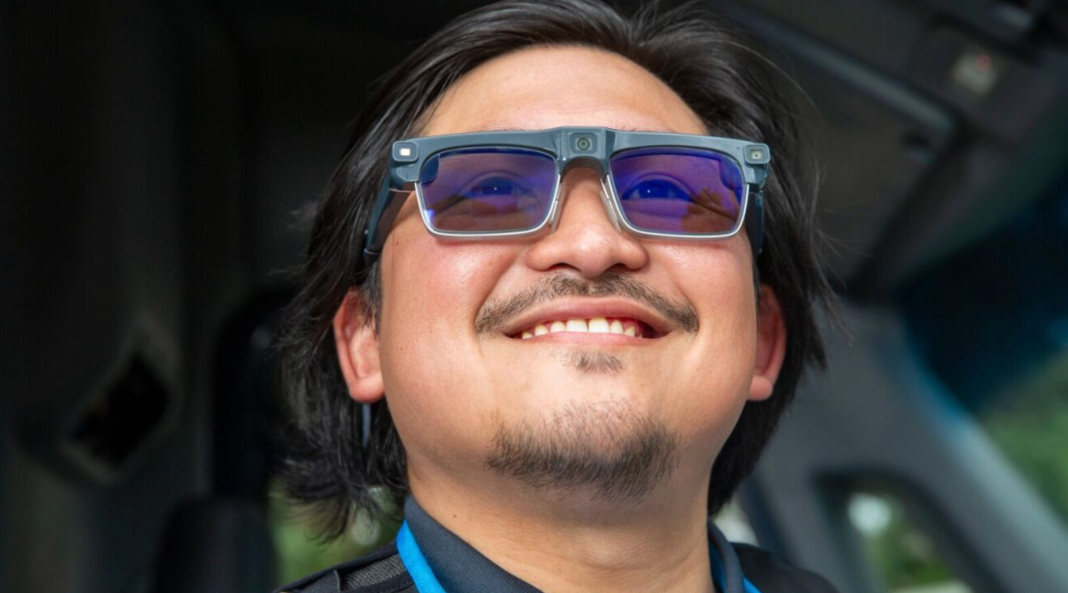Amazon is taking a bold step into wearable tech for its last-mile delivery network by unveiling Amazon AI smart glasses designed for its delivery drivers. The new device promises a hands-free, smarter delivery experience by combining augmented reality (AR), computer vision and AI.
This innovation is not only about efficiency—it reflects how Amazon is using hardware, data and AI to enhance operational workflows.
What the Amazon AI smart glasses do
Here are the standout features of Amazon’s delivery-focused smart glasses:
- They allow delivery associates to scan packages, get turn-by-turn walking navigation, and capture proof of delivery without pulling out their phones.
- The glasses use AI-powered sensing capabilities and computer vision, enabling options like hazard detection (e.g., pets, low light) and package mis-deliveries.
- Activation is automatic: when the driver parks at a drop-off location, the glasses kick in and guide from inside the van to the doorstep.
- The system includes a vest-worn controller housing operational controls, a swappable battery and an emergency button.
- The glasses support prescription lenses and photo-chromic/transitional lenses to adapt to different lighting.
Why this move matters
Efficiency & delivery economics
By reducing micro-motions (like looking down at a phone, switching between package and map), the glasses aim to shave seconds off each stop. Over thousands of deliveries, that cumulative time saving can be substantial. India Today
Safety & situational awareness
Mounting navigation or delivery instructions in the driver’s field of view helps keep their eyes on the environment rather than shifting between phone and sidewalk. That can help prevent mis-deliveries, slips/trips, or navigating complex multi-unit addresses.
Data & AI feedback loop
The wearable device isn’t just a gadget—it’s a data-collection instrument. Each moment becomes an opportunity for Amazon’s algorithms to learn: recognizing patterns of drops, hazards, walking paths, mis-deliveries. This data can refine route planning, driver training, and warehouse-to-door processes.
Operational branding & future hardware ambitions
While these glasses are oriented at delivery drivers, they also position Amazon in the wearable tech space (hinting at future consumer-grade glasses) and show how deeply Amazon is integrating hardware, software and logistics.
Challenges & open questions
- Driver adoption & comfort: Even with prescription-lenses support, wearing hardware all day poses a comfort and ergonomics challenge. The vest controller adds bulk.
- Privacy & monitoring concerns: With glasses capturing package scans, doorsteps, walking routes and potentially video/audio, drivers or third-party DSPs may raise concerns around surveillance, data usage and consent.
- Reliability in real-world environments: The technology must work across urban, suburban, complex multi-unit buildings, variable lighting, weather, network conditions, etc. Early pilot-phases matter.
- Cost vs benefit: The cost of each unit plus associated infrastructure/training must deliver sufficient ROI (time saved, fewer errors, improved safety) for Amazon to scale.
- Scaling globally/locally: Although the pilot is in North America, deploying in India (or other large delivery markets) may face additional localization, lens/cultural/terrain issues.
What this means for India & global last-mile logistics
For markets like India with dense housing, narrow lanes, variable infrastructure and high courier volumes:
- The glasses could help address “last 50-100 yards” delivery complexity in apartment clusters, gated colonies or busy streets by providing real-time navigation, occupant recognition or package-to-door mapping.
- Local adaptation (Indian addresses, languages, lighting conditions, informal routes) will matter—Amazon’s global logistics might test/adjust versions here.
- If successful, this wearable tech could raise the bar for what a delivery driver “toolkit” looks like in emerging markets—beyond smartphones/handheld scanners.
- However, costs and logistics (battery life, repair/maintenance, training) will influence how widely this is adopted globally.
Context: Amazon’s broader AI & wearable strategy
The smart glasses announcement sits alongside other Amazon innovations:
- Amazon’s “Blue Jay” robotics system for warehouse picking.
- Amazon’s consumer AR glasses project (codenamed “Jayhawk”) slated for later launch, hinting that the delivery glasses are also stepping-stones toward a broader ecosystem.
Thus, while the immediate focus is on logistics, the larger vision appears to include wearables + AR + AI for workforce and consumer markets.
Conclusion
Amazon’s unveiling of its AI smart glasses for delivery drivers marks a significant step in how wearable technology and AI can intersect with logistics. The Amazon AI smart glasses tie together navigation, package scanning, hazard detection and hands-free delivery execution in one device. While many technical, operational and human-factors challenges remain, the innovation could reshape last-mile delivery workflows—and hint at Amazon’s larger ambitions in wearable/AR tech.



